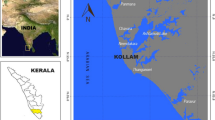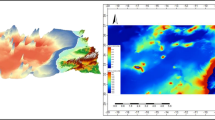Abstract
In this study, we integrate remote sensing in oceanographic studies and coastal engineering projects by using satellite images to extract the values of suspended matter in the water and track sediment transport along the coastline. We used Sentinel-2 products and Case 2 Regional Coastcolor (C2RCC) plugin to extract Total Suspended Matter (TSM) values on the Algerian coast for the last six years to construct a database for future studies. We then used the processed products to assess sediment transport in the region of Cap Djinet, where the fishing port suffers from a notably high sedimentation phenomenon. In the last part of the study, we tried to find a correlation between TSM-extracted values and measured depths. Remote sensing was also combined with in situ depth measurements, which we used to construct a bathymetric map of the port. Using satellite imagery, we could assess the damage done to the port throughout the years. We were also able to understand better the causes of this problem, which helped us determine why the solutions implemented by the authorities did not work.
Access provided by Autonomous University of Puebla. Download conference paper PDF
Similar content being viewed by others
Keywords
1 Introduction
Algeria has a coastline of almost 1600 km. The Algerian government has built numerous fishing ports along the coastline to exploit the country’s halieutic resources better. Numerical methods are used to quantify sediment transport for the choice of port site. The results of MIKE21 gave us a favorable opinion for selecting the location of the port of Cap Djanet. In 2006 the port was constructed. After a few years, the sedimentation problem started, mainly in the southern region of the port. The problem became evident in 2011. In 2009, a study was carried out to solve the problem by modifying the port’s design. Also, dredging of the port was carried out, but the problem persists. It is interesting to follow the results of sediment transport from space by remote sensing (Cherif et al., 2019).
2 Materials and Methods
2.1 Study Area
The Cap Djinet harbor is located about 75 km east of Algiers, protected by two jetties and groynes. The main one is about 580 m to the north. The second is in the entrance pass in the south with a length of 340 m. The groynes to the north are 160 m, and the other to the south 120 m. Along the coastline is a long beach, extending from the mouth of Wadi Isser in the west to the mouth of Wadi Sebaou in the east. For monitoring the coastline, we used Google Images taken over several dates.
2.2 Processing Sentinel Data
The processing of images from the Sentinel satellite is presented in the following Fig. 1.
Finally, the resulting products were processed using the C2RCC plugin, which gives a product containing both TSM values (Sent et al., 2021). We can then extract TSM values from any point we want using the Pin manager tool. The extracted values are then loaded into Excel for further manipulation.
2.3 In Situ Measurement
To calibrate the models used, we need to make in situ bathymetry measurements and the concentration of suspended matter (TSM). As for the depth measurements, we used a Plastimo Echotest II depth sounder and measured the TSM using a multiparameter’s HANNA. We took depth measurements from 329 different points.
3 Results
From the shoreline changes, we can see that the sedimentation levels have increased, especially in the southern and eastern parts. The region under the northern spur has also been subjected to the same phenomenon. From the coasts extracted from the satellite images, we can conclude that the changes made in 2011 and 2014 failed to resolve the problem and that sedimentation continued (Islam et al., 2017) (Fig. 2).
From the images, we can see that the shoreline drift current prevents the sediment coming from Wadi Sebaou from moving toward the west. It also prevents it from leaving the coast into deep waters, forcing some sediment to move along the coastline toward the west and directly into the northern part of the harbor (Fig. 3).
As for the western region, we can see that the sediment is being directly transported toward the harbor (Filipponi, 2018). Finally, we are interested in looking for a correlation between the TSM and the Z bathymetry. The correlation between TSM and Z is essential and reaches 0.91, provided that the depth is between 0.8 and 25 m. The bathymetric map produced is injected into the MIKE-21 model. After several configurations, we propose the optimal solution is to extend the groyne further into the water. In this case, the sedimentation takes place in front of the port in the area with high bathymetry. The silting time of the port is long if it takes place.
4 Conclusions
This work has allowed us to conclude an essential aspect of coastal engineering in the feasibility studies on the site choice for a harbor project. The numerical and reduced models must integrate remote sensing before starting the modeling phase. It is necessary to add the satellite image before and after the floods to decide on the feasibility of the harbor structure.
References
Cherif, Y. S., Mezouar, K., Guerfi, M., & Sallaye, M. (2019). Nearshore hydrodynamics and sediment transport processes along the sandy coast of Boumerdes, Algeria. Arabian Journal of Geosciences, 12(24), 1–17. https://doi.org/10.1007/s12517-019-4981-0
El Islam, B. N., Fouzia, H., & Khalid, A. (2017). Combination of satellite images and numerical model for the state followed the coast of the bay of BejaiaJijel. International Journal of Environment and Geoinformatics, 4(1), 1–7. https://doi.org/10.30897/ijegeo.306486
Filipponi, F. (2018). River color monitoring using optical satellite data. Proceedings, 2(10), 569. https://doi.org/10.3390/iecg_2018-05336
Sent, G., Biguino, B., Favareto, L., Cruz, J., Sá, C., Dogliotti, A. I., Palma, C., Brotas, V., & Brito, A. C. (2021). Deriving water quality parameters using Sentinel-2 imagery: A case study in the Sado Estuary, Portugal. Remote Sensing, 13, 1043. https://doi.org/10.3390/rs13051043
Author information
Authors and Affiliations
Corresponding author
Editor information
Editors and Affiliations
Rights and permissions
Copyright information
© 2023 The Author(s), under exclusive license to Springer Nature Switzerland AG
About this paper
Cite this paper
Bachari, N.e.i., Dahmani, H., Lamri, N., Mazouzi, M., Bensari, B., Houma, F. (2023). Contribution of Google Earth and Images from the Sentinel-2 Satellite to the Monitoring of the Silting of Cap Djinet Harbor (Algeria). In: Çiner, A., et al. Recent Research on Environmental Earth Sciences, Geomorphology, Soil Science, Paleoclimate, and Karst. MedGU 2021. Advances in Science, Technology & Innovation. Springer, Cham. https://doi.org/10.1007/978-3-031-42917-0_18
Download citation
DOI: https://doi.org/10.1007/978-3-031-42917-0_18
Published:
Publisher Name: Springer, Cham
Print ISBN: 978-3-031-42916-3
Online ISBN: 978-3-031-42917-0
eBook Packages: Earth and Environmental ScienceEarth and Environmental Science (R0)







